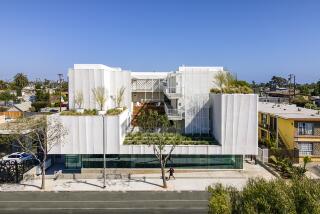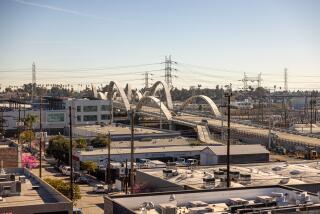Some fear Arts District development plan would ruin the neighborhood
Architect Mark Rothenberg listened as the young city planner answered questions about a sweeping new vision for how the downtown Arts District should grow. Then, point by point, Rothenberg, who has lived in the district for more than two decades, delivered an earful about how it was all wrong.
And he wasn’t the only one unhappy.
More than 200 other residents came to the district’s Angel City Brewery recently to hear about proposed guidelines that could add up to 1,500 residential units and potentially double the population of their community.
Unveiled last month, the draft plan permits construction of apartment buildings that are taller and denser than the low-slung brick warehouses and vacant manufacturing plants that artists and gallery owners have converted into airy lofts and workspaces over three decades.
Now that high-end boutiques and coffeehouses have arrived, developers are eager to meet the demand for more housing. Residents, however, are worried that too much change too fast will forever alter the artsy, industrial vibe that attracted them to the community.
“Do we want it to just become a place of high-density population?” asked Yuval Bar-Zemer, a longtime resident and developer. “Or a place that appeals to the creative class and allows space for the creative dynamic to grow?”
Battles over increasing density are common in Los Angeles as city leaders, led by Mayor Eric Garcetti, push for compact, walkable and less-polluting “smart growth” developments close to transit lines. But when those projects arrive in established neighborhoods, they’ve often been a tough sell.
Hollywood residents for years have fought developers’ plans to erect sleek Manhattan-style condo towers next to streets filled with postwar bungalows and hillside mansions. In downtown Los Angeles, condo owners at Flower Street Lofts unsuccessfully fought the planned construction of a 28-story residential tower on what is now a parking lot, saying it would block sunlight from their four-story building.
But the Arts District, spread over 52 gritty blocks east of Little Tokyo and west of the Los Angeles River, was until now largely immune from those fights. It grew organically, block by block, from a pocket of abandoned industrial buildings prowled by transients into a still raw but thriving mecca for young professionals in creative industries, including L.A.’s huge TV and film industry.
On weekends, bearded men, as well as women in trendy outfits, form lines to enter Urth Caffe, one of the district’s hot new bistros. Across the street, lofts at the newly opened Barker Block are selling for more than $1 million. But there aren’t enough housing options to satisfy the newly upmarket demand, developers say, and the process for converting industrial buildings is onerous and costly.
Planners at City Hall have been working on the draft law for about a year, said Patricia Diefenderfer, a senior city planner. It would allow for residential projects that are not permitted today, she said.
She compared it to the city’s adoption of 1999’s adaptive-reuse ordinance easing rules for converting old office buildings into housing. That law is widely credited with helping fire downtown’s renaissance by making it cheaper for developers to retrofit older buildings. The Arts District version is different, she noted, in that it addresses ground-up residential construction, not conversions.
“The goal is to continue to maintain the area so that it generates jobs and to capitalize on the creative activities that take place currently,” she said.
The Planning Commission is set to consider the plan at its Dec. 18 meeting. If approved, it would move to the City Council next year.
Developers would be able to build structures up to 100 feet high or about eight stories. That is double the current industrial zoning limit of four stories.
In return for greater density, the only type of unit allowed would be so-called live-work spaces with high ceilings and open floor plans. Builders also would be required to offer “public benefits” such as affordable-housing units, communal workspaces, art murals facing the streets and pedestrian paths that connect the community. Retail and restaurants at the ground level would also be permitted.
Manny Roshan, a former fabric wholesaler turned developer, said he’s eager to convert a warehouse and parking lot that he owns on Mateo Street into a six-story residential complex with a restaurant at the ground floor. He thinks the new guidelines would help protect the district’s character, not diminish it. “This is doing exactly what the city wants,’’ he said.
Mark Tarczynski, a broker with Colliers International, said that about 9,000 new residential units were already in the pipeline for the greater downtown area. Young people raised in suburbs are clamoring to live in a Los Angeles core that is both urban and walkable, he said, and the Arts District is seen as a creative subset of that.
“It’s a neighborhood of concertina wire, warehouses and graffiti,’’ Tarczynski said. “It’s not for everyone. But there is a certain market that seeks it out. It’s counterculture.”
The district is already home to the Southern California Institute of Architecture and will soon house a 30,000-square-foot “clean tech” incubator for green-technology start-ups. Earlier this month, investors announced they would convert a century-old former Coca-Cola factory into office space for firms in the technology, entertainment and fashion fields.
One Santa Fe, a 438-apartment behemoth, meanwhile, opened in summer to mixed reviews. Some residents have likened its linear design to a cruise ship; others praise it as a nod to the area’s rail yard history.
Opposition to the development plan has centered on two major points. Residents say they want more time to study the proposed law and suggest changes. Critics also want the city to appoint an architectural review board to weigh in on the design of new projects.
“Wall-to-wall fortress buildings have no linkage to the community,’’ said Rothenberg, the architect who was fuming at the Angel City Brewery meeting. “Most developers are bottom-line oriented, and that’s fine. But if you don’t have stringent guidelines in place, they will take every opportunity to maximize their profits.”
Nevin and Megan Seus, who bought a unit last year in a converted storage warehouse known as Beacon Lofts, are among those distressed by possible changes. An apartment complex planned for the parking lot next to their building is “too massive” for the space, says Nevin Seus, a music editor.
And at six stories high, it would block prime downtown skyline views from the Loft’s rooftop patio — their only communal space, Seus said.
“People wake up and realize that the neighborhood we like so much could change in a really drastic way,’’ he said.
For some, the debate is simply a reflection of a neighborhood in transition. Carol Schatz of the Central City Assn., a downtown business group, called it evidence that the Arts District has reached “critical mass.”
“It’s the price of success,’’ she said.
catherine.saillant@latimes.com
Twitter: @csaillant2
More to Read
Sign up for Essential California
The most important California stories and recommendations in your inbox every morning.
You may occasionally receive promotional content from the Los Angeles Times.







